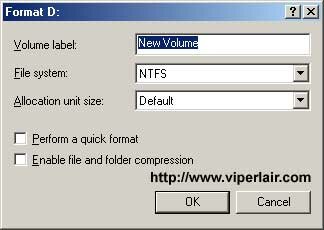|
Format as NTFS, using Disk Management, in Windows 2000
Let's say that you already have Windows setup, but didn't format it into NTFS, or it wasn't formatted in NTFS when it was given to you. Well, it isn't too late. Using a tool called Disk Management (Disk Administrator in NT), you can format whatever drives, except for CD drives, and your system (\winnt) drive.
If you practice good habits, and setup multiple partitions, you'll save files onto other partitions other than c:. This way, if Windows dies on you, your data is safe. However, this poses problems for you formatting your d:, e:, etc..., partitions in Disk Management. Formatting your drives in this tool will destroy all data on them. I said it once, I'll say it again, do regular backups and you'll be ok. If you don't have access to removable storage, then move all your data to another partition and format each drive one by one. I prefer this method over right clicking a drive in Windows Explorer and selecting format, because Disk Management provides a lot more options and you can see more of what is happening.
To get to Disk Aministrator, simply click on Start, then Settings, Control Panel, then double click Administrative Tools, then double click Computer Management. A new console will appear. Expand the Storage tree, and click on Disk Management.You'll get a window that appears like this:

Note: You will need to be logged in as an Administrator to do these changes.
Once the tool is open, you select which partition you want to reformat. Select it, then right click. A pop up window will appear, and you can select Format.

Another pop up will appear, and you can choose a volume name, file system and cluster size. I usually leave it at default. Make sure you choose NTFS, since that's the whole point of this guide. :P

It's best to not select a quick format since there may be errors if you have a shaky disk. I also wouldn't bother using file compression since it's going to slow you down.
Previous Page - NTFS Pre-Installing Windows
Next Page - NTFS in DOS Window
|
